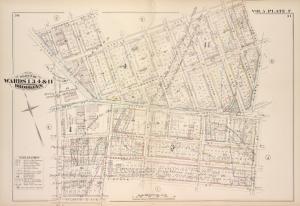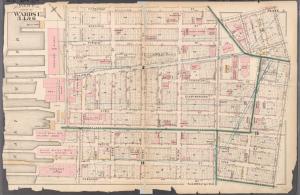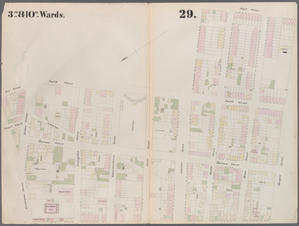 |
| Original photo from the 1923-24 BFS School Catalogue |
Brooklyn Friends School opened on the 9th of September in 1867 in the Brooklyn Meeting House on Schermerhorn Street. This opening occurred only about nine months after the subject of adding a "Preparative Meeting School" was first broached by the Women's Meeting of Brooklyn Preparative Meeting, the precursor of today's Brooklyn Monthly Meeting. It is possible that some Brooklyn Quakers sent their children to Friends Seminary before the Brooklyn school opened, but they desired their own separate school. The idea was approved by Brooklyn Preparative Meeting, and this was followed by approval from Brooklyn's "parent" meeting, New York Monthly Meeting (known since 1974 as New York Quarterly Meeting). New York Monthly Meeting also oversaw the preparative meetings in Manhattan, and it already had an experienced board of trustees in place for Friends Seminary in Manhattan (that first school board was known at times as the "School Committee"). Later that year, New York Monthly Meeting united with Brooklyn Preparative Meeting that "Friends School at Brooklyn"would operate under the same board of trustees as Friends Seminary, so it became the "Schools Committee" of New York Monthly Meeting.
 |
| View the original image at the Brooklyn Public Library's Brooklyn Collection |
BFS opened with one teacher, our first Principal Mary Haviland, and our first students numbered 17 in September of 1867, but enrollment increased to 32 students by the end of that first year. The school's enrollment grew to at least 48 students the following year, so Clara Lockwood was engaged as our second teacher and she became Principal in 1873 when Mary Haviland resigned. Both women were Quakers, as were approximately half of our students.
To understand Brooklyn Friends School's physical expansion, it helps to understand how the Brooklyn Meeting House on Schermerhorn came into being in 1857 and to have a grasp of the layout of the entire Schermerhorn property. I can't draw or even cut a straight line, so my modifications to photos are neither great nor exact, but they give perspective. There will not be a quiz at a later date.
The Brooklyn Meeting House was built a little east-of-center of the original five adjacent lots purchased by New York Monthly Meeting - lots which would later be known as 102, 104, 106, 108 and 110 Schermerhorn - on the Schermerhorn side of the block bounded by Schermerhorn, Smith, State and Boerum Place. This block was located within one of the old Schermerhorn "farms" in Brooklyn, yet the Schermerhorns - brothers Peter and Abraham - lived in Manhattan, though they summered at their Gowanus farm. The Schermerhorn Street farm was clearly not pastoral as the Schermerhorn Street block just east, bordered by Smith, Bond and State Streets, was the site of the Schermerhorn ropewalk. Ropewalks are long buildings designed for the manufacture of rope, and they were notorious in other eras for both accidental and arson fires, and for the harsh conditions for employees. This Schermerhorn ropewalk was over 1200 feet in length, apparently the largest ropewalk in the United States at the time. It was destroyed by a spectacular fire in 1841 and never rebuilt, which the Common Council for the City of Brooklyn was apparently happy about as the ropewalk had hindered development in the immediate area.

Brooklyn was going through significant booms in both immigration and in development during the 1840s and 1850s, so in high demand were the areas closest to the Navy Yard and to Brooklyn's historic commercial center, its waterfront in the area now considered DuMBO and Brooklyn Heights. Beginning in the early years of the 19th Century, the Street Commissioner of the City of Brooklyn was regularly giving notice of the opening of streets through private property, thus enabling Brooklyn's Common Council to create the streets and blocks we know today. The September 2, 1847 edition of the Brooklyn Eagle saw the publication of the street opening notice for Schermerhorn Street between Boerum and Smith Streets. With even more growth still to come, Brooklyn was the third largest city in the United States by 1860.
These five lots on Schermerhorn were purchased in 1856 by New York Monthly Meeting for $10,000 (at $2000 apiece), chosen for being very close to City Hall and easily accessible by the "City Hall Rail Roads" - the Brooklyn City Railroad which ran streetcars, was established in 1853, and expanded into the BMT in later years. The design of the Brooklyn Meeting House is attributed to architect and "master builder" Charles T. Bunting, a member of New York Monthly Meeting, who later designed a similar building for what is now considered the 15th Street Monthly Meeting and Friends Seminary complex in Manhattan for their 1860 move to Rutherford Place from Elizabeth Street. The cost of building the Brooklyn Meeting House was estimated to be $16,000 and the 1836 Brooklyn Meeting House at Henry and Clark Streets was sold by New York Monthly Meeting to pay for the new one on Schermerhorn. If inspired, one can read a lovely overview of the Brooklyn Meeting House, from the New York City Landmarks Preservation Commission.
Between 1855 and 1880, a factory was built at 98-100 Schermerhorn on the two lots just west of the five lots purchased by New York Monthly Meeting. This factory also encompassed 43-61 Boerum Place and 225 State Street, the entire western-most lots of the block. This is the same factory with the wall that some BFS alumni remember playing ball against, and which was razed for the widening of Boerum Place in the 1960s. That widening of Boerum Place also took some of the Quaker-owned site, seemingly the entire lot of 102 Schermerhorn and some, if not all, of the 104 Schermerhorn lot. Based on an 1850 advertisement in The Brooklyn Daily Eagle, it is possible that an earlier wood-frame house stood at what was once 98 Schermerhorn, flanked by two open lots at 96 and 100 Schermerhorn, but street numbers often change over time.
The factory housed many manufacturers over the years: maps indicate it was the "Brooklyn Butter Co.," a "button works," plumbing and boiler works, machine works (Roover Bros. which made everything from embossing machines to coin-operated amusement park machines). I've read that there were various showrooms on the Boerum Place side, and I've read it was the home of the Zeman Brothers' shirtwaist factory. It seems to have been a commercial building which rented to several manufacturers, sometimes simultaneously.

An 1880 map indicates that the Meeting House, the factory, and two brownstone rowhouses at 116 and 118 Schermerhorn were the only buildings on this side of the fully laid-out block. 116 and 118 were likely built by the same developer in 1857-1858, as 116 was offered for sale as new in March, 1858 in The Brooklyn Daily Eagle. At some point before 1880, both houses seem to have begun operating as boarding houses, which would continue throughout their existence. A few brick or brownstone rowhouses were also on the State Street and Smith Street sides of the block. An 1855 map shows the entire block was a "florist's garden,"which newspapers indicate was a nursery owned by the noted horticulturalist H.A. Graef. This"florist's garden" continued operations for several years on the undeveloped eastern lots and fronted on Smith Street.

While Brooklyn was known for its farms in its very earliest days, the word "farm" has to be viewed more liberally in an area that has almost always been quite urban. Brooklyn had always been a port city in its own right. Fulton Ferry Landing was the historic downtown of the Town of Brooklyn, and the areas nearest the waterfront were highly desirable for housing and commercial purposes. Brooklyn was but one of the six original towns that made up Kings County and which were unified in the period stretching from 1854 to 1886, before becoming a borough of the City of New York in 1898. As a child, my first grown-up friend was a 90-year old neighbor, the artist Nell Choate Jones who moved to Brooklyn from rural Georgia in 1884 when she was five years old. She grew up in Bedford Stuyvesant in the City of Brooklyn and once fondly recalled her earliest days in Brooklyn, remarking that if one took a long enough walk south on Flatbush Avenue in the 19th Century, one could still eventually hit true farms then, just like those she remembered from Georgia, but that those Brooklyn farms were soon all gone.
No comments:
Post a Comment